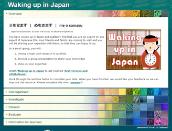 Waking up in Japan
Waking up in Japan
TLF ID M020840
This resource embeds the use of online collaboration tools and 21st century learning skills to support students studying the 100-hour mandatory Stage 4 or 100/200 elective Stage 5 Japanese courses. Students work collaboratively to research a topic of cultural interest in Japan and make a presentation (digital and/or face-to-face) that demonstrates their learning. They investigate key Japanese words (Stage 4) and conduct a Japanese Q&A interview (Stage 5) related to their chosen topic.
